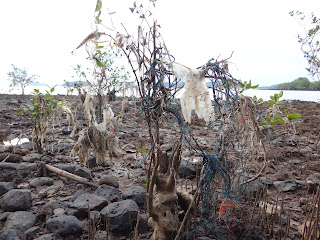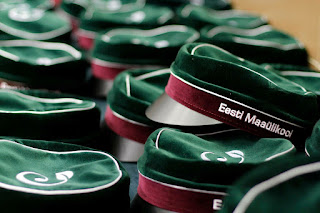Let me talk trash again
There is
this one topic you must have noticed coming up in all of my latest stories. My
war against plastic. I can be seen with that reusable cup all day long, with
tea in it on my way to work, water throughout the day, and ice tea after lunch…
I bring my own water bottle, reuse bags until they basically fall apart – but
on some days, I’m too slow to say “no straw please”, or I can’t find what I
need without plastic packaging – or people simply don’t get what my problem is.
One of the students saw me wash out the bag I had bought rice in. “What are you
doing?” she asked. “So I can use again”, I answered in that simplified English
I needed to use with them. And immediately she offered to organize a new bag
for me, no problem.
Plastic is
everywhere. A study recently even found it in human poop. And while in Germany
the “zero waste movement” is growing and more and more people are aware of the
problems plastic causes, that we need to stop consuming it if we want to save
what we have left of our natural habitat (and everyone else’s) – in Thailand
we’re not quite there yet. Yes, awareness is growing. More and more people
bring their own cups (but then use a new plastic straw for every drink), there
are recycling facilities, supermarkets sell reusable bags and people actually
bring them when they go shopping; and the Khao Kheow Open Zoo shows an ad for
reusable take-away containers and mugs. But the trash is still omnipresent.
Nothing comes without a plastic bag, not even the single coke bottle. Little
restaurants use the single-portion instant noodle bags for cooking, we find the
plastic on the beaches of the most beautiful islands, and picking it up on my
way to work is like Groundhog Day.
There are some great campaigns going on on instagram, like "3 trash per day" or "Is this yours?" where you tag the producer
So let’s
talk about the problem I have.
More than
70 billion plastic bags are being used in Thailand every year, on average eight
per person and day (!) – mostly just to transport something from the store to
the house, the average time that these bags are used is twelve minutes. And
they are made from a material that will still be there in 450 years. Around 100
000 marine animals die every year because of plastic bags, ingesting them,
mostly, but strangulations also occur.
Another
problem are straws. There is a slogan going around on social media at the
moment: “It’s just one straw – said 8 billion people”. It’s not that single
straw that causes the problem – it’s the mass of them. Because they are so
small, we often don’t think about them too much. But their size is also why
they can’t be recycled: they are so small and lightweight that they just fall
through at the sorting machines – if they even make it there. In Germany, we
use about 10 billion straws per year, in the US it’s 500 million a day – so
more than 180 billion in a year. And in these masses, they are not so lightweight
anymore: it’s estimated that 25 000 tons of plastic waste are straws. They need
about 200 years to decompose – that is, to break into microplastics. In beach
clean-ups in January 2019, plastic straws were the most commonly found items. I
could write a whole article about how the trash always ends up in the oceans,
but in short: this little, light straw falls out of the bin on the sidewalk,
all it needs is a little wind. It flies through the city until it lands in a
river, and the floating begins. Towards the ocean, where it will break under
the influence of salt, sun, sand and everything else, and gets smaller and smaller.
We’ve all
seen this picture of the jellyfish and the plastic bags: “You see the difference
– a turtle odes not”. But even worse are the smaller pieces – microplastics are
roughly the size of plankton, to they are easy to confuse with the base of the
marine food chain: the plastic gets into the tiny fish that is eaten by a small
fish that is eaten by a bigger fish and so on. And whales who first take
everything onto their mouths that they find and then filter out the water
ingest even more of that. And other trash. You’ll find lots of cases in the media
of wales that were found dead on the coast, starved – their digestive tract
full of trash. There was a case in Thailand, too, last June, raising more
awareness on the problem here: a whale had ingested 80 plastic bags.
 |
| inner organs of a sperm whale stranded in Germany photo: Institut für Terrestrische und Auatische Wildtierforschung, TiHo |
 But not
only marine life is affected. In my first week at the large animal hospital in
Bangkok we had a bovine patient with watery diarrhea and weight loss. None of
the treatments were successful, so finally the vets decided on an explorative
laparotomy: surgery to look for a cause. They suspected a reticulopertitonitis
traumatica – an inflammation of one of the forestomachs and the heart sac,
caused by a foreign body that pierced its way through both organs. This is a
common disease in cattle, as they don’t pay much attention to what they eat. In
Germany, it’s mostly caused by nails and other pieces of metal, so most farmers
give them magnets – these will fall into the forestomach and stay there, collect
any metal items and won’t cause any harm themselves. So I naturally asked the
vet if this was common practice in Thailand as well. “No” said she, “the
foreign bodies are usually plastic. That’s what’s lying around in the fields.”
But not
only marine life is affected. In my first week at the large animal hospital in
Bangkok we had a bovine patient with watery diarrhea and weight loss. None of
the treatments were successful, so finally the vets decided on an explorative
laparotomy: surgery to look for a cause. They suspected a reticulopertitonitis
traumatica – an inflammation of one of the forestomachs and the heart sac,
caused by a foreign body that pierced its way through both organs. This is a
common disease in cattle, as they don’t pay much attention to what they eat. In
Germany, it’s mostly caused by nails and other pieces of metal, so most farmers
give them magnets – these will fall into the forestomach and stay there, collect
any metal items and won’t cause any harm themselves. So I naturally asked the
vet if this was common practice in Thailand as well. “No” said she, “the
foreign bodies are usually plastic. That’s what’s lying around in the fields.”
80 percent
of the trash in the oceans is land-originated (so only 20 percent are fishing
nets and the like), and 90 percent of that is plastic.
Every year,
80 million tons of single-use plastics are being thrown away. This includes the
22 000 tons of plastic cutlery, the above mentioned bags and straws, 52 million
bottles of shampoo and shower gel, and plastic packaging. The EU ban of plastic
coffee stirrers, cutlery and straws is just a drop in the ocean, so to say.
The US
produce 17.5 million tons of plastic packaging every year (and packaging is 34
percent of all plastic production), but only 13 million tons can be traced in
disposal. That means, in the US alone, every year, four and a half million tons
of plastic just vanish. And most likely end up in some animals stomach sooner
or later.
I could go
on like this, and I probably will.
But these
are some of the reasons why I say no to straws, why I always, always, always
bring my own bag. And why I pick up trash on the side of the road when I’m
walking past it.
Sources:
Earthday.org
Indiatimes.com
wired.comonegreenplanet.org
lakhawon island
get-green-now.com
ocean conservatory report
biologicaldiversity.org
Edward
Humes
Garbology: Our Dirty Love Affair with Trash
336 pages, Avery Verlag,
2013
ISBN: 978-1583335239









Kommentare
Kommentar veröffentlichen